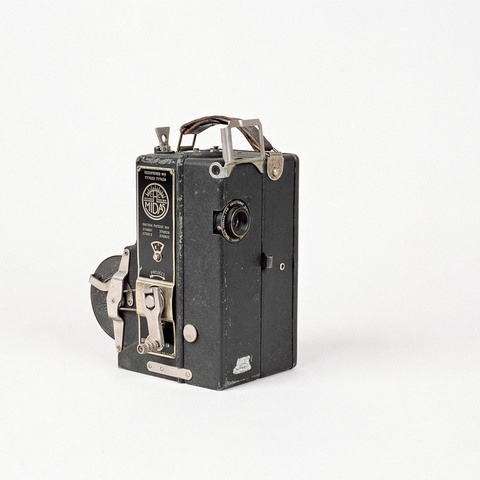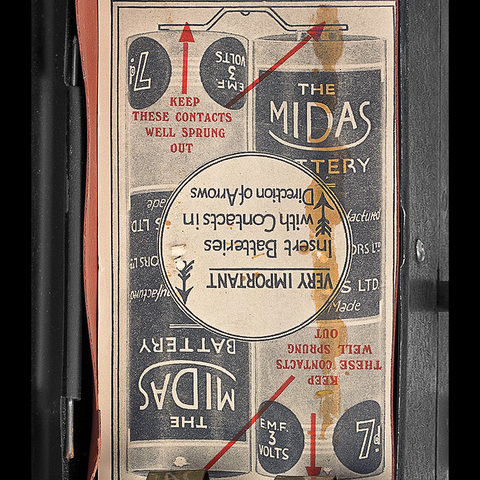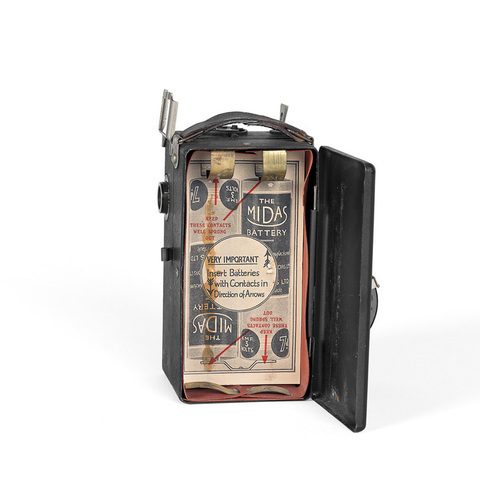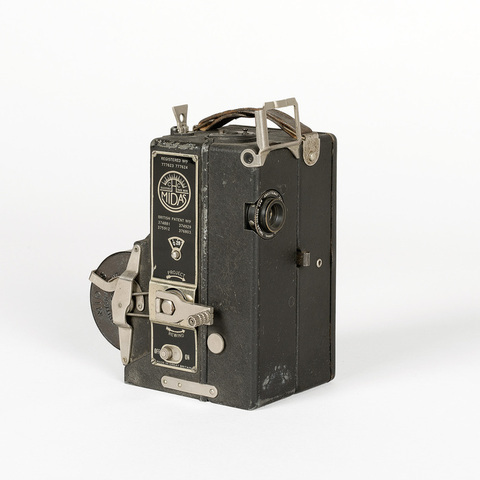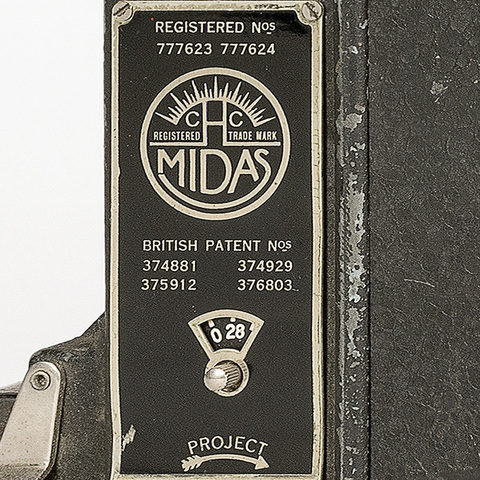Caméra réversible film 9,5 mm
Fiche détaillée
Type de l'appareil
entraînement du film 9,5 mm par deux griffes ; deux débiteurs dentés ; deux magasins 30 pieds débiteur et récepteur extérieurs et disposés à l'arrière ; lanterne et ampoule électrique incorporées ; moteur électrique alimenté par piles ; réservoir détachable pour deux piles électriques 3 volts ; compteur de pieds ; manivelle ; viseur extérieur à deux pointeurs métalliques ; poignée
Auteurs
Hillery-Collings Charles Edward
Londres, 9N Camberwell Green Estate
Fabricants
Camera Projector LTD
Londres, Bush House, Aldwych, W.C. 2
Midas
Londres
Utilisateurs
Hillery-Collings Charles Edward
Londres, 9N Camberwell Green Estate
Distributeurs
Informations non disponibles
Sujet du modèle
Informations non disponibles
Objectif
Taylor-Hobson Cam Anastigmat f. 2,5/2,8/4 /5-6/8/11/16 Pat. 155 460
Taille de l'objet
Ouvert :
Informations non disponibles
Fermé :
Longueur : 12.5 cm
Largeur : 10 cm
Hauteur : 16.5 cm
Diamètre :
Informations non disponibles
Taille de la boîte de transport
Informations non disponibles
Remarques
Marque : "Registered n° 777 623, 777 624. CC Registered Trade Mark. Midas. British Patent n° 374 881, 374 929, 375 912, 376 803. Made in Great Britain".
"The apparatus, which is known as the Midas, has now been shown to the public in the Ciné Section of the Ideal Home Exhibition at Olympia, where it proved one of the most popular of all the exhibits. [...] The apparatus itself consists of a rectangular box about 3 inches by 3 inches by 5 1/2 inches with a film holding mechanism projecting, when loaded, about another 2 inches. The shape of the apparatus is thus rather unconventional. The main portion if the case is divided into two parts, which clip together in use, one section containing the operating mechanism, lens, film chamber, etc., and the other two standard torch batteries, which can be obtained from any electrical shop or from most chemists. One of the many interesting novelties in this apparatus is that the camera mechanism is actuated by a miniature electric motor concealed in the base, the power for this being provided from the two torch batteries. It is claimed by the makers that this pair of batteries, which cost 8 d. each, will provide enough power to expose thirty of forty 30 foot reels of film and although we have not operated the camera on enough reels to check this claim the statement seems reasonnable having regard to the efficiency and low current consumption of the motor and the smoothness with which the drive mechanism operates. When used for projecting a hand drive is used, the batteries now serving to provide power for the small 6 volt lamp which illuminates the film. The taking lens, which is a Taylor Hobson anastigmat with a maximum aperture of f. 2,5, also serves for projection. When taking, the lens is used at a fixed focus but in projection focusing is effected by a small milled wheel on the top of the camera" (Home Movies & Home Talkies, juin 1933, p. 14).
"First Delivery Date. June 1st. Midas combined Camera & Projector. Price £ 7. 7. 0 complete" (Home Movies & Home Talkies, juin 1933, p. 2).
"Optical system - fixed focus : f/2.5 Taylor-Hobson anastigmat lens ; iris diaphragm ; mangin mirror lamp and condenser. Standard flashlight fitting, 4,5 volt spotlight, 0,3 amp. special patented filament-centring device, enabling the correct optical centre to be instantly set. Power : contains its own source of electric power for drive of film in camera and illumiation in projector. 3 pole armature 35% Cobalt steel, permanent magnet motor, low consumption of approx. 0,3 amp. Current supplied by 2-3 volt batteries. No clockwork motor to wind. Finish : black crystalline enamel ; all external fittings heavily plated. Loading : loading, which is simplicity itself, is exactly the same for both taking and projecting ; daylight-loading charger containing 30 ft. high speed, fine-grain film, or super-speed panchromatic film. Correct lenght of loops automatically formed when closing the apparatus. Sprocket feed and take-up. Perfect photographic and projecting performance. Pictures can be shown anywhere. Raising the front direct vision viewfinder automatically sets the focus for taking pictures. Simple rewind without removing film from the camera-projector. Back viewfinder acts also as switch for projection lamp. Stills for any lenght of time. Footage indicator, framing device, etc." (Home Movies & Home Talkies, juillet 1933).
"With the Midas combined Camera-projector you have a complete self-contained instrument capable of carrying out the functions both of taking and projecting high-grade moving pictures. The taking mechanism is operated by an electric motor driven by two 3 volt batteries carried in the instrument itself - the same batteries supply the illumination for projecting. Thus with the Midas you can show pictures anywhere and at any time. The f. 2.5 Taylor-Hobson anastigmat is an optical refinement worthy of your special note. The Midas is a British Made precision instrument and is backed by extensive scientific research. Complete Negative Film, 30 ft. high speed, fine grain 9,5 mm, film in daylight charger, including free development as a negative, price 2 s. 9 d. Positive print : from 30 ft. negative, price 3 s." (Home Movies & Home Talkies, juin 1934, p. 2).
"The apparatus is made in two parts - one part contains the mechanism for taking and for projecting pictures, whilst the other part is a container for the batteries supplying electric current for the motor when taking, and for the lamp when projecting. For normal use, special Midas 3-volt dry batteries of the torch lamp pattern, are supplied as standard equipment. When taking photographs, the current is required for running the motor, and a set of batteries will take some 50 films. Its is not recommended to use the motor when projecting, because the current is then required for the illuminant ; the cranking handle should then be used. If a 6-volt accumulator is used instead of dry batteries it will provide sufficient current for both the motor and illuminant. [...] If the camera is loaded with negative film, of which part only has been exposed, and it is desired to use the Midas for projection, proceed as follows (a dark room is not necessary) : open the camera, lift the gate and disengage the film loop ; lift the stirrup, withdraw the charger and put it away, leaving the loop hanging out. Then project as usual. When ready to expose the remainder of the negative film, reload the camera in the normal way, being especially careful to follow the instructions to ensure that the take-up is working, and proceed to take pictures. You will only waste (by light fog) a little over one foot of film ; the daylight charger protect the rest. [...] To use the Midas as a projector two single spool boxes are required. These are supplied with the camera-projector when purchased. Every positive print from a customer's negative is returned from the processing station in a single spool box, with the developed negative in a separate envelope. When it is desired to project, one empty single spool box will be required to take-up the film from the full spool box. [...] To show a picture, turn the cranking handle in a clockwise direction (as indicated by the arrow marked "Project") with your right hand, using your left hand to hold the instrument steady. Crank steadily and evenly, using your wrist rather than your arm. Two turns of the handle per second will give you the correct speed. The size of the projected picture depends upon the distance of the screen from the instrument. Always rewind the film after projection. [...] The electric bulb supplied with the Midas is of a type which will stand hard usage over an extended period. Replacements can be obtained from us, but any standard 4,5 volt 0,3 ampere flash lamp bulb can be used in an emergency with very fair results" (The Midas Combined Camera-Projector and How to Use It, London, Camera-Projectors Limited, [1934]).
Bibliographie
Home Movies & Home Talkies, juin 1933.
Home Movies & Home Talkies, juillet 1933.
Home Movies & Home Talkies, juin 1934.
Home Movies & Home Talkies, juin 1935.
The Midas Combined Camera-Projector and How to Use It, London, Camera-Projectors Limited, [1934].
